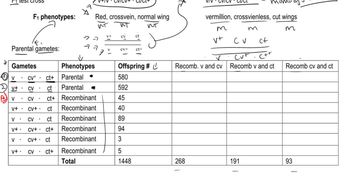Table of contents
- 1. Introduction to Genetics51m
- 2. Mendel's Laws of Inheritance3h 37m
- 3. Extensions to Mendelian Inheritance2h 41m
- 4. Genetic Mapping and Linkage2h 28m
- 5. Genetics of Bacteria and Viruses1h 21m
- 6. Chromosomal Variation1h 48m
- 7. DNA and Chromosome Structure56m
- 8. DNA Replication1h 10m
- 9. Mitosis and Meiosis1h 34m
- 10. Transcription1h 0m
- 11. Translation58m
- 12. Gene Regulation in Prokaryotes1h 19m
- 13. Gene Regulation in Eukaryotes44m
- 14. Genetic Control of Development44m
- 15. Genomes and Genomics1h 50m
- 16. Transposable Elements47m
- 17. Mutation, Repair, and Recombination1h 6m
- 18. Molecular Genetic Tools19m
- 19. Cancer Genetics29m
- 20. Quantitative Genetics1h 26m
- 21. Population Genetics50m
- 22. Evolutionary Genetics29m
3. Extensions to Mendelian Inheritance
Organelle DNA
Problem 3
Textbook Question
Streptomycin resistance in Chlamydomonas may result from a mutation in either a chloroplast gene or a nuclear gene. What phenotypic results would occur in a cross between a member of an mt⁺ strain resistant in both genes and a member of a strain sensitive to the antibiotic? What results would occur in the reciprocal cross?
 Verified step by step guidance
Verified step by step guidance1
Understand the genetic basis of streptomycin resistance: Resistance can arise from mutations in either a chloroplast gene (which is maternally inherited in Chlamydomonas) or a nuclear gene (which follows Mendelian inheritance).
Analyze the first cross: In the cross between an mt⁺ strain resistant in both genes (chloroplast and nuclear) and an mt⁻ strain sensitive to the antibiotic, the chloroplast genes will be inherited from the mt⁺ parent, while nuclear genes will segregate according to Mendelian inheritance.
Predict the phenotypes for the first cross: Since the mt⁺ parent contributes the chloroplast genome, all offspring will inherit the resistant chloroplast gene. For the nuclear gene, offspring will inherit one resistant allele from the mt⁺ parent and one sensitive allele from the mt⁻ parent, resulting in a heterozygous nuclear genotype.
Analyze the reciprocal cross: In the reciprocal cross, where the mt⁻ strain (sensitive) is the chloroplast donor and the mt⁺ strain (resistant) is the nuclear donor, the chloroplast genome will be inherited from the mt⁻ parent, making all offspring sensitive in terms of chloroplast resistance. The nuclear gene will segregate as before, resulting in heterozygous nuclear genotypes.
Summarize the phenotypic results: In the first cross, all offspring will be resistant due to the resistant chloroplast gene, regardless of the nuclear genotype. In the reciprocal cross, all offspring will be sensitive due to the sensitive chloroplast gene, even though they carry one resistant nuclear allele.
 Verified video answer for a similar problem:
Verified video answer for a similar problem:This video solution was recommended by our tutors as helpful for the problem above
Video duration:
2mPlay a video:
Was this helpful?
Key Concepts
Here are the essential concepts you must grasp in order to answer the question correctly.
Chloroplast and Nuclear Genes
Chloroplast genes are inherited maternally and are located in the chloroplasts, while nuclear genes are found in the cell nucleus and follow Mendelian inheritance patterns. In Chlamydomonas, mutations in either type of gene can lead to phenotypic changes, such as antibiotic resistance. Understanding the distinction between these gene types is crucial for predicting inheritance patterns in crosses.
Recommended video:
Guided course

Mapping Genes
Phenotypic Expression
Phenotypic expression refers to the observable traits or characteristics of an organism resulting from the interaction of its genotype with the environment. In the context of the question, the phenotypic results of the crosses will depend on whether the resistance alleles are dominant or recessive and how they interact in the offspring. This concept is essential for predicting the outcomes of genetic crosses.
Recommended video:
Guided course

Penetrance and Expressivity
Reciprocal Crosses
A reciprocal cross involves swapping the roles of the parents in a genetic cross to determine if the inheritance pattern changes. In this case, crossing an mt⁺ strain resistant in both genes with a sensitive strain and then performing the reverse cross can reveal insights into the genetic basis of resistance. Analyzing the results of both crosses helps clarify the inheritance of traits linked to chloroplast and nuclear genes.
Recommended video:
Guided course

Trihybrid Cross

 4:11m
4:11mWatch next
Master Organelle DNA Characteristics with a bite sized video explanation from Kylia
Start learningRelated Videos
Related Practice
Multiple Choice
Which of the following is encoded by mitochondrial DNA?
2
views
